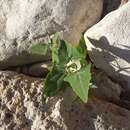zh-TW
在導航的名稱


Die Aucher-Melde (Atriplex aucheri) ist eine Pflanzenart aus der Gattung der Melden (Atriplex) in der Familie der Fuchsschwanzgewächse (Amaranthaceae). Sie gilt als wilde Ausgangsform der kultivierten Gartenmelde.
Die Aucher-Melde wächst als einjährige krautige Pflanze, die Wuchshöhen von 40 bis 180 cm (selten bis 250 cm) erreicht. Der aufrechte, im Querschnitt unten stielrunde, oben etwas viereckige Stängel ist meist verzweigt mit schräg abstehenden, oft bemehlten Seitenzweigen.
Die Laubblätter sind im unten am Stängel gegenständig, weiter oben wechselständig angeordnet. Sie erreichen eine Länge von 4 bis 10 cm und eine Breite von 2 bis 8 cm. Sie sind 1 bis 3 cm lang gestielt. Die oberseits dunkelgrüne, unterseits dicht grau-weißlich durch Blasenhaare bemehlte Blattspreite ist konkav gebogen und an den oberen Blättern oft tütenförmig eingerollt. Die Spreitenform der unteren Blätter ist dreieckig-spießförmig mit ausgezogenen Spießecken und gestutztem oder herzförmigem Grund. Die der oberen Blätter ist dreieckig-lanzettlich bis länglich verkehrt-eiförmig, mit keilförmigem Grund. Der Blattrand ist grob buchtig gezähnt, mit verlängertem zweiten basalen Zahnpaar, gelegentlich auch fast ganzrandig. Der Geschmack der Blätter wird als mild beschrieben.
Die Blütezeit beginnt in Deutschland erst Anfang September (nach Schwarz 2004. In der Flora Iranica wird eine Blütezeit von April bis Mai und in der Flora of China von August bis Oktober angegeben). In endständigen, verzweigten, ährigen Blütenständen stehen Knäuel aus meist sechs grünen, oft rötlich überlaufenen Blüten in der Achsel von Tragblättern.
Es gibt zwittrige, männliche und zwei Typen von weiblichen Blüten. Die zwittrigen Blüten enthalten fünf längliche Blütenhüllblätter (Tepalen), fünf Staubblätter und einen horizontalen Fruchtknoten. Bei den männlichen Blüten fehlt der Fruchtknoten, bei einigen weiblichen "horizontalen" Blüten sind die Staubblätter nicht entwickelt. Die meisten weiblichen Blüten sind "vertikal": sie werden von zwei Vorblättern umhüllt, Blütenhüllblätter sind nicht vorhanden, sie enthalten nur einen vertikalen Fruchtknoten.
Der Fruchtstand ist zur Fruchtzeit (in Deutschland ab November) durch sein Gewicht stark überhängend. Es gibt mehrere Typen von Früchten (Heterokarpie): In den "horizontalen" Blüten umgeben die Blütenhüllblätter die horizontale Frucht von etwa 1,5 mm Durchmesser mit schwarzer, glatter Samenschale.
Die vertikale Frucht bleibt von den freien Vorblättern umhüllt, die sich auf 10 bis 15 mm Länge und 9 bis 12 mm Breite vergrößern. Die trockenen Vorblätter sind strohgelb, teilweise auch rötlich überlaufen oder mit rötlichem Rand. Die Form der Vorblätter ist oval-eiförmig oder rundlich, nicht oder wenig zugespitzt oder leicht ausgerandet und ganzrandig. Ihre Oberfläche zeigt eine netzartige Aderung, die Hauptadern trennen sich erst nach einem Fünftel bis einem Viertel der Vorblattlänge. Es kommen zwei vertikale Samentypen vor: gelbbraune Samen mit einem Durchmesser von 3 bis 4 mm und matter, durchscheinender Samenschale, sowie kleinere schwarze Samen, die oft noch lange Griffelreste tragen und nach Abreiben der dünnen Fruchtwand glänzend sind.
Die Chromosomenzahl beträgt nach Untersuchungen von Schwarz (2004) etwa 2n=18.
Atriplex aucheri ist eine C3-Pflanze mit normaler Blattanatomie[1].
Atriplex aucheri ist in Mittelasien heimisch. Von Südosteuropa (Ukraine, südosteuropäisches Russland), der Türkei und der Kaukasus-Region reicht ihr Verbreitungsgebiet über den nördlichen Iran, Afghanistan, Turkmenistan, Kasachstan und Kirgisien bis zum chinesischen Xinjiang.
Eingeführt als Adventivpflanze ist sie auch in Deutschland, Estland und dem europäischen Russland gefunden worden[2].
Sie besiedelt Steppen, auch auf salzigen Böden, Kiesgeröll oder Ufer von Gewässern, kommt aber auch an Straßenrändern oder als Unkraut in Gärten vor. Im Iran kann sie bis zu einer Höhenlage von 2500 Meter gedeihen.
Die Aucher-Melde (Atriplex aucheri) zählt innerhalb der Gattung Atriplex zur Sektion Atriplex[1]. Sie ist eng verwandt mit der Gartenmelde (Atriplex hortensis) und der Glanz-Melde (Atriplex sagittata) und wird möglicherweise häufig mit diesen verwechselt.
Die Erstveröffentlichung von Atriplex aucheri Moq. erfolgte 1840 durch Alfred Moquin-Tandon in Chenopodearum Monographica Enumeratio, S. 51[3]. Der Artname bezieht sich auf den Botaniker und Forschungsreisenden Pierre Martin Rémi Aucher-Éloy, von dem das Typusexemplar stammt.
Synonyme von Atriplex aucheri Moq. sind Atriplex amblyostegia Turcz., Atriplex desertorum Sosn., Atriplex hortensis subsp. desertorum (Iljin) Aellen, Atriplex nitens subsp. aucheri (Moq.) Takht. und Atriplex nitens subsp. desertorum Iljin[3].
Die Aucher-Melde (Atriplex aucheri) ist eine Pflanzenart aus der Gattung der Melden (Atriplex) in der Familie der Fuchsschwanzgewächse (Amaranthaceae). Sie gilt als wilde Ausgangsform der kultivierten Gartenmelde.
Atriplex aucheri là loài thực vật có hoa thuộc họ Dền. Loài này được Moq. mô tả khoa học đầu tiên năm 1840.[1]
Atriplex aucheri là loài thực vật có hoa thuộc họ Dền. Loài này được Moq. mô tả khoa học đầu tiên năm 1840.